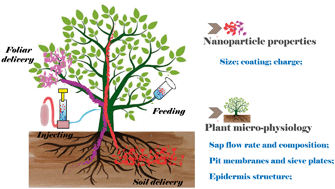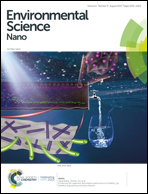Delivery, uptake, fate, and transport of engineered nanoparticles in plants: a critical review and data analysis†
Abstract
The increasing demand for food coupled to various environmental pressures, is increasing the importance of sustainable agricultural practices. Based on results published across a wide range of disciplines, it is becoming evident that nanotechnology can play a crucial role in increasing the sustainability of agriculture, particularly in the area of fertilizer delivery, gene modification, and pest control. In this paper, we review critical plant morphological and physiological indices (pore size in xylem and phloem, xylem/phloem sap composition, xylem/phloem sap flow rate and flow conducting area) for nanoparticle (NP) transport, and examine the efficacy of various delivery methods for NPs (foliar application, root application, and feeding/injecting directly into plant tissue) with an emphasis on NP transport efficiency throughout the entire plant. While only few studies have explored the feeding/injection of NPs, these application pathways are the most efficient in terms of delivery, indicating their practical potential (e.g., for agrochemical delivery). In contrast, when applied via soil drenching or foliar spraying, the majority of the applied NPs are not taken up by the plants. However, those NPs that do penetrate the plant exhibit efficient transport from leaf to root, and vice versa. Of these two application methods, foliar application appears to be more effective in both NP delivery and transport than soil drenching. To further explain the data reported in the literature and to study the transport processes of NPs throughout the plant, we applied the Derjaguin–Landau–Verwey–Overbeek model to study the interactions of NPs with the surfaces of the plant vascular system (xylem and phloem), by which these NPs are transported throughout the plant structure. We found that the interaction energy between negatively charged NPs and plant tissue is positive, indicating that these NPs can effectively transport. We discuss future research needs regarding NP transport, which will enable effective utilization of NPs for different agricultural applications.



 Please wait while we load your content...
Please wait while we load your content...